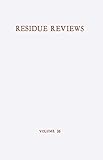Residue reviews: residues of pesticides and other foreign chemicals in foods and feeds [Libro electrónico] / editor: Francis A. Gunther
Gunther, Francis A [editor].
Tipo de material: Libro
en línea Series Editor: New York: Springer-Verlag, c1969Descripción: vii, 144 páginas : ilustraciones.ISBN: 9781461584483 (Print); 9781461584469 (Online).Nota de acceso: Disponible para usuarios de ECOSUR con su clave de acceso Nota de bibliografía: Incluye bibliografía e índice: páginas 139-142 Número de sistema: 55409Contenidos:Mostrar
Resumen:
Libro
en línea Series Editor: New York: Springer-Verlag, c1969Descripción: vii, 144 páginas : ilustraciones.ISBN: 9781461584483 (Print); 9781461584469 (Online).Nota de acceso: Disponible para usuarios de ECOSUR con su clave de acceso Nota de bibliografía: Incluye bibliografía e índice: páginas 139-142 Número de sistema: 55409Contenidos:Mostrar
Resumen:| Tipo de ítem | Biblioteca actual | Colección | Signatura | Estado | Fecha de vencimiento | Código de barras |
|---|---|---|---|---|---|---|
| Libros | Biblioteca Electrónica Recursos en línea (RE) | Acervo General | Recurso digital | ECO400554091396 |
Incluye bibliografía e índice: páginas 139-142
1. Pesticide regulations and residue problems in japan.. 2. Determination of organophosphorus pesticides in water.. 3. Toxicity and hazards to man, domestic animals, and wildlife from some commonly used auxin herbicides.. 4. A specific gas chromatographic method for residues of organic nitrogen pesticides.. 5. Significance of organochlorine insecticide residues in fresh plants as possible contaminants of milk and beef products.. 6. Potential interferences in certain pesticide residue analyses from organochlorine compounds occurring naturally in plants.. Subject Index
Disponible para usuarios de ECOSUR con su clave de acceso
That residues of pesticide and other "foreign" chemicals in food stuffs are of concern to everyone everywhere is amply attested by the reception accorded previous volumes of "Residue Reviews" and by the gratifying enthUSiasm, sincerity, and efforts shown by all the individ uals from whom manuscripts have been solicited. Despite much propaganda to the contrary, there can never be any serious question that pest-control chemicals and food-additive chemicals are essential to adequate food production, manufacture, marketing, and storage, yet without continuing surveillance and intelligent control some of those that persist in our foodstuffs could at times conceivably endanger the public health. Ensuring safety-in-use of these many chemicals is a dynamic challenge, for established ones are continually being dis placed by newly developed ones more acceptable to food technologists, pharmacologists, toxicologists, and changing pest-control requirements in progressive food-prodUCing economies. These matters are also of genuine concern to increasing numbers of governmental agencies and legislative bodies around the world, for some of these chemicals have resulted in a few mishaps from improper use. Adequate safety-in-use evaluations of any of these chemicals per sisting into our foodstuffs are not simple matters, and they incorporate the considered judgments of many individuals highly trained in a variety of complex biological, chemical, food. technological, medical, pharmacological, and toxicological disciplines. eng
Disponible en línea
Disponible en formato PDF
Subscripción a ELSEVIER 26 de diciembre del 2013
